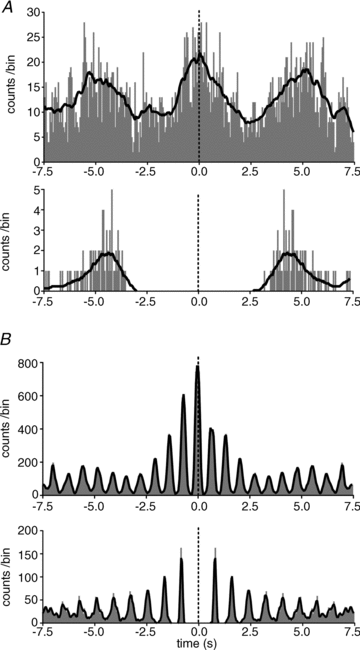Respiratory modulation of muscle sympathetic nerve activity is not increased in essential hypertension or chronic obstructive pulmonary disease
- PMID: 21844003
- PMCID: PMC3224888
- DOI: 10.1113/jphysiol.2011.210534
Respiratory modulation of muscle sympathetic nerve activity is not increased in essential hypertension or chronic obstructive pulmonary disease
Abstract
We examined cardiac and respiratory modulation of muscle sympathetic nerve activity (MSNA) in 13 patients with essential hypertension (HT) and 15 with chronic obstructive pulmonary disease (COPD), and compared these with a group of young healthy controls (YHC) and older healthy controls (OHC). There were no significant differences in age of the OHC and HT subjects. MSNA was recorded via a tungsten microelectrode inserted percutaneously into the common peroneal nerve. Respiration was recorded by a strain-gauge transducer around the chest and ECG recorded by surface electrodes. Cardiac and respiratory modulation of MSNA was quantified by fitting polynomials to the cross-correlation histograms constructed between the sympathetic spikes and ECG or respiration. Cardiac modulation was high across all groups, but was significantly lower in COPD (75.9 ± 4.4%) than in the HT (92.4 ± 3.0%), OHC (93.7 ± 1.3%) or YHC (89.1 ± 1.6%) groups. Across all groups, respiratory modulation was significantly lower than cardiac modulation. Respiratory modulation in HT (45.2 ± 5.7%) and COPD (37.5 ± 6.3%) was not higher than in the OHC (47.2 ± 5.4%) or YHC (49.5 ± 6.0%) groups. We have shown that respiratory modulation of MSNA is present in all groups, is consistently lower than the magnitude of cardiac modulation, and is not increased in HT or COPD, arguing against an amplified respiratory-sympathetic coupling in hypertension. Moreover, given that patients with COPD are chronically asphyxic, these data indicate that an increased chemical drive does not increase respiratory modulation of MSNA.
Figures




References
-
- Bainton CR, Richter DW, Seller H, Ballantyne D, Klein JP. Respiratory modulation of sympathetic activity. J Autonom Nerv Syst. 1985;12:77–90. - PubMed
-
- Barman SM, Gebber GL. Basis for synchronization of sympathetic and phrenic nerve discharges. Am J Physiol. 1976;231:1601–1607. - PubMed
-
- Bent LR, Bolton PS, Macefield VG. Modulation of muscle sympathetic bursts by sinusoidal galvanic vestibular stimulation in human subjects. Exp Brain Res. 2006;174:701–711. - PubMed
MeSH terms
LinkOut - more resources
Full Text Sources
Medical

